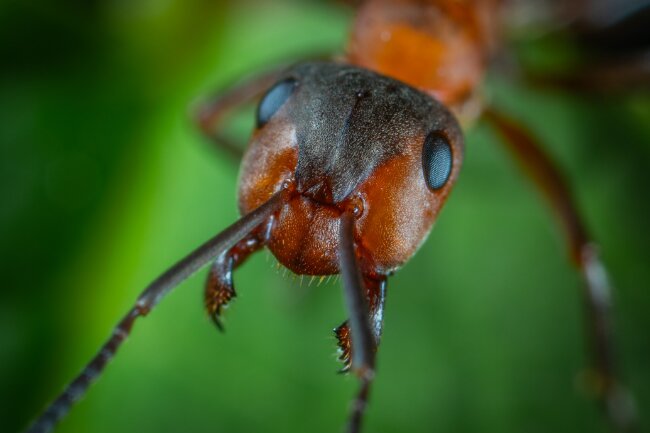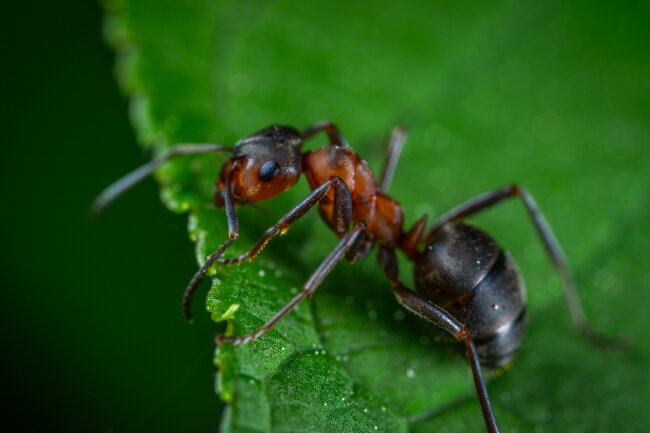Ants do have eyes, however the number and their uses vary both between species and even between different individuals within a colony. Most species have a pair of compound eyes, while some species have additional simple eyes in the centre of their heads, usually three, though a few have only one.
Contents
Many ways to see
Eyes are amazingly diverse across the animal kingdom. Depending on how they function, they can pick up vastly different wavelengths and details. Some insects are able to see ultraviolet light, for example, while the simple eyes of caterpillars are only able to see light and dark.
Eyes have evolved over millennia, first appearing over 500 million years ago. Loosely, these eyes can be divided into two groups, simple eyes and compound eyes. Simple eyes are not necessarily simple in nature, but are made of one lens rather than many. Compound eyes are made of many lenses that help to build an overall picture.
Human eyes are a form of simple eye, as are the eyes of cephalopods and crustaceans. Compound eyes are common amongst insects. These are made up of a number of smaller lenses known as ocelli. These ocelli pick up individual pictures, which are then translated by the insect’s brain.
Compound eyes can have many benefits, one being the opportunity for almost 360 degrees vision.
Seeing through the eye of an ant

There are around 12,000 species of ant across the world, adapted to live in different climates, habitats and environments. How they live and what form they take significantly impacts the type of vision they have evolved. Even within colonies, there can be differences between different types of ants.
Ants need sight for a wide range of different reasons. Being able to see can help them locate food and mates. It can also warn them of a predator approaching or other forms of danger. Importantly, it can also help them to navigate, to find their way to and from their nests.
| Characteristic | Compound Eyes | Simple Eyes |
|---|---|---|
| Structure | Made up of numerous individual lenses | Single lens or ocelli |
| Vision | Wide field of view | Limited vision, primarily light detection |
| Light Sensitivity | Sensitive to light changes | Less sensitive to light changes |
| Focus | Can focus on objects at different distances | Generally fixed focus |
| Image Resolution | Low resolution | Higher resolution in some cases |
| Color Perception | Limited color perception | Limited or no color perception |
Ants’ head shape can vary in terms of shape and size, however they are generally composed of a large pair of mandibles, a pair of compound eyes and two antennae set slightly in front of their eyes. Ants do not have noses, with the antennae doing the job of detecting chemical signals, while holes in their exoskeleton allow them to breathe.
Also read: Do Ants have Lungs? Do They Need Oxygen to Breathe?
In general, most species have two large compound eyes. Compound eyes are made of a large number of individual ocelli. The individual ocelli are surrounded by screening pigments to prevent them from picking up light. These eyes are thought to produce a fairly blurry picture, meaning that many ant species cannot detect obstacles until they are relatively close.
The number of ocelli varies across different species. Those with fewer ocelli have poorer vision. In general, smaller ant species have fewer ocelli due to the effects of miniaturisation. It has also been found that females and males tend to have a higher number of ocelli than worker ants.
The ants’ large compound eyes have been found to be able to detect polarised light. They can use this to help work out which direction they are heading in. Whether ants can detect colour depends on the species. Some can see in colour, whereas others appear to be colour blind. Some ants can also detect ultraviolet light.

Some Bullet ants have some of the best eyesight of all ant species. It has also been found that ants that hunt prey and flying ants are likely to have better eyesight, as they have more use for it than other species.
A very small number of ant species are completely blind and do not have these compound eyes. This is the case in the worker ants of many army ant species, though some may have single-lens eyes.
As well as compound eyes ants have some ocelli in the centre of their heads. These vary between different ant species. The majority of ants do not have central ocelli, however some like desert ants and bull ants have a set of three set in a triangle formation.
Within flying ant species winged males and females have also been found with to have three large ocelli.
Fish-hook ants are fascinating species that are found in Indo-China. Polyrhachis ypsilon is a beautiful golden species with unusual hooks extending from their exoskeleton. They have an additional unusual feature in that they are one of the few species to have only one ocellus in the centre of their heads.
Research into the purpose of the ocelli in ants is fairly limited, however, it seems ants use them to help sense polarised light and navigate by it. The size of the individual ocelli has been found to be generally larger in night-active species, suggesting they could be useful in light sensing.
| Adaptation | Description |
|---|---|
| Compound Eye Structure | Allows for a wide field of view and detection of movement |
| Sensitivity to Light | Enables ants to detect changes in light intensity and navigate |
| Visual Navigation | Helps ants find food sources, navigate their environment, and recognize nestmates |
Studies on desert ants have found that they may use their ocelli to help find the shortest route home by using visual cues.
Also read: If You Wonder “Do Ants Have Bones?” (Exoskeletons Explained)
Beyond sight
In many animal species, sight isn’t as important a sense as it is in humans. Other senses are relied on more heavily. In ants, chemical signals are incredibly important. For this purpose, ants have a pair of antennae, arranged in an elbow shape.
The ants use their antennae in all kinds of ways. The joints allow them to move them to feel objects, and also to pick up scents. The scents are detected by chemical detectors located in hair-like sensors on the surface of the ant’s skin.
It’s through the use of these sensors that blind ant species can get around safely. Scent trails are often used, where individual ants lay down chemical pheromones that other ants can then follow. This is generally the case where ants can be seen walking in lines, appearing to be following one another.
Also read: 4 Smells Ants Hate The Most (incl. Salt & Vinegar)
An Ant’s Eye View
Ants do not have great eyesight compared to many insects. Yet, surprisingly, it doesn’t seem to have slowed the march of their armies. Ants can be found across almost every continent in the world, in a wide range of habitats.
The lack of investment in their eyesight is likely to be because they are so adapted to using their other senses, in particular their ability to detect minute chemical signals. Where these insects have developed better eyesight, it tends to be because there is a particular advantage, such as with mating individuals.

